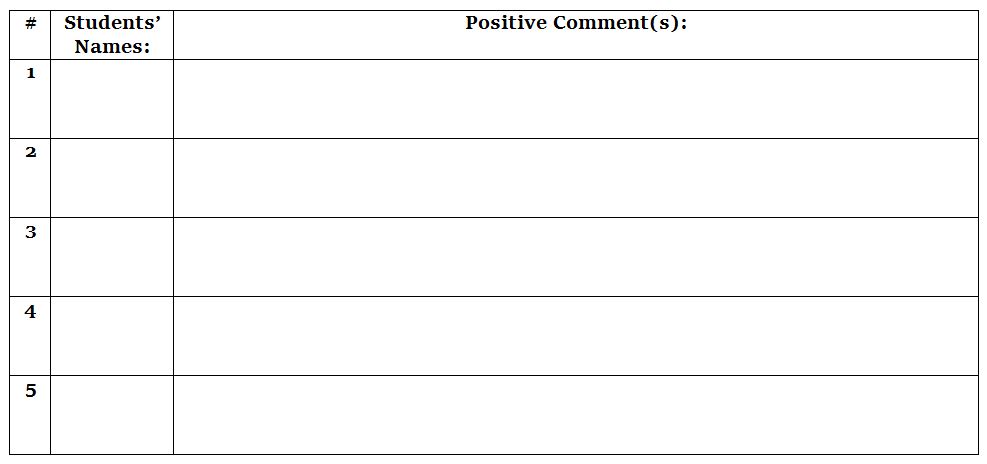8 Steps to Start a Power of Praise Program
10/15/2016

Do you spend more time calling parents on a student's bad behavior or good behavior? If I could give one piece of advice for new teachers, new administrators, or other educators wanting to change the culture of their school or classroom, it would be to start a Power of Praise Program. You can start small and add to make it as big as you can handle. I have to give credit for this program to a recently retired colleague, a Nationally Distinguished Principal, Bill Salonen from Great Falls, Montana. I have only modified it slightly, but have used it to drive other positive behavior interventions! Here are eight steps you can use to start a successful Power of Praise Program:
STEP 1: Go Public with Your Philosophy
If an educator in a different school asked you what your principal believes in, how would you answer? Some principals go through the motions without ever pronouncing their beliefs, and some speak so freely that their philosophy contradicts itself routinely. Do your research, build your philosophy from experiences…that of your district, and most importantly the people you work with daily. If your staff's philosophy contradicts yours, start with small increments of change. Changing philosophy takes time and this program could help! If you believe in a positive environment that feeds on itself, tell your staff, tell your community, and then make some actionable goals. Tell your staff,
"We are going to put more time into positive behaviors than negative behaviors. I believe we can start with everyone giving me one positive thing about every student in our school."
STEP 2: Ask for Ideas, Get Buy-In
Asking for ideas from your staff on how to praise the positive things students do in our school. Hopefully your staff can brain storm more ideas. If this is difficult, then this is time well spent until they can! A healthy staff should be able to brainstorm a comprehensive list on how they can acknowledge the positives. You probably can't put all the ideas into practice, but keep this list. You can pull it out and add to it any time, and you can also use their ideas later to change things up. Make sure you use some of the ideas so staff believes you care, that you can listen, and that you can follow through by putting them into action. Buy-in is hard to get, but if you work at it and go with the "go-ers" the bus will start to move!
STEP 3: Describe Power of Praise Program (Make sure to include some Ideas from Staff)
The Power of Praise Program is quite simple. Teachers find specific things that students are doing in the school that can be praised. They write them down with the student's name (see example below). Then the principal calls the parents of the student with the praise statement. Every teacher is asked to take part.
STEP 4: Set Expectations
Set the expectations for your staff. Decide if you want all staff giving you positives about students, or just the instructional staff. In my school, I leave it open to anyone…in fact a parent volunteer recently knew we were doing it and after working with a student gave me positive about a student. I require all teachers in classrooms to give me one positive comment that I can use to call on every student over the course of the school year. I tell them that some students may require more calls as they may respond to an increase in positives or they may be an at-risk student. I track each quarter how many calls they have made so far and communicate that with teachers. I ask teachers to keep a running list of which students they have given positive comments on. If they do 5-9 each quarter, they should have all students done by the end of the year. Some teachers write five comments a week for me and each student usually ends up with about 4-6 positive comments a year.
STEP 5: Make Phone Calls
The phone conversations never include the word, "BUT." The calls are only positive. If you must talk about bad behavior, make a separate call later. You would not believe the responses you get from parents. You may want to jot down some of their responses. I always ask how they are doing today; this information gives me a little insight into the parent's mood. Here is some sample language for the phone call:
"Hello. Is this Mrs. Smith. This is Johnny's principal, Mr. Konen from the elementary. How are you today? I am calling with some positive praise on Johnny (usually a good comment back here, but I have heard a gasp, or even a laugh here). Mrs. Tanner said that Johnny has improved 27 points on his last math test and she has seen vast improvements over the year. So, we are celebrating him here at school and hopefully you praise him at home. Have a great day."
STEP 6: Celebrate Landmark Numbers
Celebrate landmark phone calls. After I have made the 100th call, I see which teacher wrote it. I then celebrate it with a school-wide email and I buy them a beverage of their choice. By celebrating calls you are telling everyone that "we" are working on this goal together. It is also a fun way to get teachers to put more Power of Praise comments into the inbox. You may want to adjust the number so you give out more surprises frequently. You could track this on a poster, thermometer style, in front of your classroom or the principal's office.
STEP 7: Hold Everyone Accountable
Communicating back to staff on how many positive comments they have given you every quarter is a great way to let them know that you believe in this program, as well as letting them know if they are on track to meeting the expectation that every student gets recognized throughout the year. A teacher may say, "Well, little Johnny gets into too much trouble and he never does anything worth calling home." I challenge that teacher…BECAUSE…I was little Johnny in school. You must look for improvement, an act of kindness, or something small that you can make into a big deal! This is the student that needs more than one call home. Don't you think this student has already had a lot of negative phone calls home? My mom once told a teacher, "Well, do you want me to go down there and beat the cr*p out of him?" She was annoyed at all the negative comments. I was an "A/B" student in elementary school…she was a teacher in the building, also! You will be happy to know…I grew up! If there is a teacher that will not take part in this program, you may have to let them know this is part of the evaluation system. I have never had a teacher not participate, but I see it fitting into our Charlotte Danielson Evaluation Model under the following three Domains and four Components:
- Domain 1 Component d: Demonstrating Knowledge of Students
- Domain 2 Component c: Establishing a Culture of Learning
- Domain 4 Component a: Communicating with Families
- Domain 4 Component e: Reflecting on Professional Practice and Engaging in Professional Community
STEP 8: Build On Success
This program can be started by principals or it can be ran totally in classrooms by teachers. The power the principal has with this program is visible. Hopefully the principal's first call home on behavior is for a positive. Then, when a principal has to call on a negative behavior they have already built some rapport with the family. Also, this program combats the idea that the principal only calls home for negative behavior or when they want something. These hold true for teachers, as well. Take the positives and build on them. Connect the number of phone calls you make each month to the number of office referrals that are written. Is there a pattern? If not, increase the calls. One of the greatest things I get to tell teachers are the comments that the parents make about the teachers after I have given them the praise. It comes full circle as many parents reply about the positive experience their student is having in that specific teacher's class. Another idea is to have teachers praise other staff members in the same way. You can then read these weekly at staff meetings…a great way to end meetings with positives. Teachers like surprises; give them a tasty treat or duty coverage! You can model your teacher program off of your student program.
Though it is difficult to collect data to determine the success of a program such as this, I think it can be done! Track the number of phone calls make during times of school-wide stress. If we are feeling the stress, kids probably are, and parents, too. Track the number of phone calls made on your at-risk students. Track the teachers that turn in Power of Praise forms. Making the intangible, TANGIBLE will only highlight even more on what you and your school believe in…success begets success! Where do you want to spend your time?
The Power of Positive Praise!
Staff Member: _____________Room: ________ Date: _______
I would like to make a positive phone call home to every student's parents at least once this year. Let me know of any students you would like to see me "praise" from your class at this time. Keep track of the students you refer to make sure all students reach the minimum of one phone call this school year.
THANK YOU for supporting me with this goal!

- Learning How to Say No and Set Boundaries with Parents - November 21, 2022
- If You Had Only One Behavior Strategy to Use in Your Classroom, What Would It Be? - September 26, 2022
- Live Your Code: 7 Strategies That Will Help You Be the Most Effective Educator You Can Be - August 15, 2022










